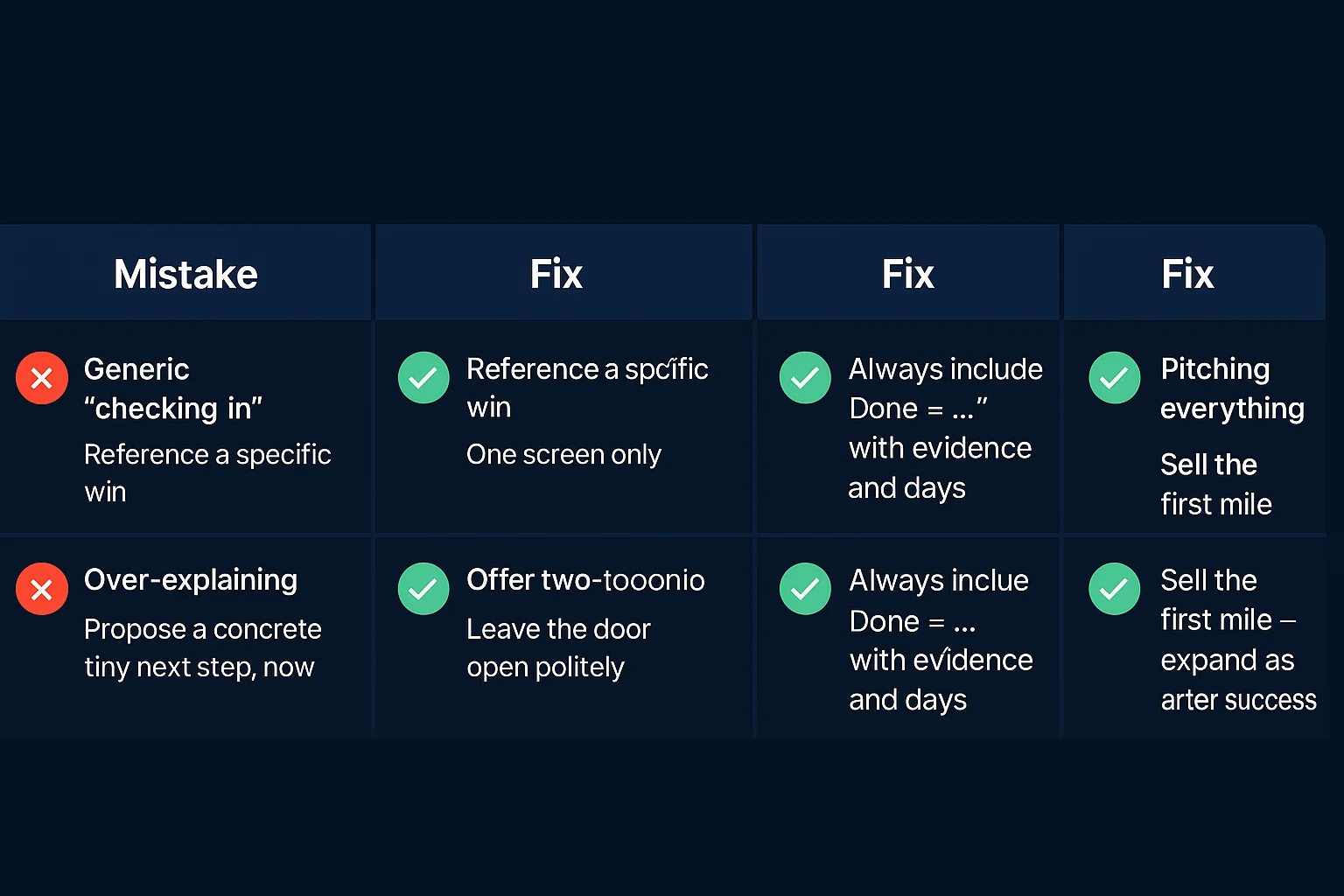Every agency wants more leads. But the fastest path to new revenue is the thread you’ve already opened: past clients, paused contracts, and prospects who went silent after shortlisting you. These people know your name, your work, and your cadence. The trust tax is already paid. A thoughtful upwork client win back program turns dormancy into deals with far less effort than cold bidding—often in days, not weeks.
Re-engagement works because timing changes. Stakeholders shift, priorities resurface, or budgets reset at quarter-end. Your job isn’t to “sell again”; it’s to reduce friction to a tiny yes, remind them of the outcomes you delivered, and propose one small, decisionable next step. Do this respectfully—once or twice, not ten times—and you’ll reengage Upwork client relationships without sounding desperate.
The win-back mindset: service, not nagging
A great upwork follow up old client message doesn’t ask for favors; it offers value. You’re returning with an insight, a small asset, or a maintenance plan that protects their previous investment. Keep it phone-length (150–220 words), anchored in a result they cared about, and end with a simple choice. If your note reads like a newsletter blast, it will be ignored. If it reads like proactive account management, it gets replies.
Key principles you’ll see throughout this playbook:
- Reference a concrete past outcome (metric, milestone, artifact).
- Propose a micro-engagement with Done = … acceptance criteria.
- Offer two options (call vs 2-slide plan; lean vs standard) to lower decision load.
- Respect the inbox: one or two touches, not a weekly drip forever.
Targeting: who to approach first (and who to skip)
Start with three buckets:
- Recent wins (last 6–12 months): measurable outcomes, clean handoff, good rapport. These are prime for a light maintenance or improvement sprint.
- Warm inactives: clients who paused for budget/priority reasons but expressed satisfaction. Re-open with a health check or “Protect & Improve” retainer.
- Stalled shortlists: prospects who liked you but chose timing over fit. Send a concise progress-checking note and a tiny first-mile offer.
Skip clients with unresolved disputes, unclear owners, or mismatched expectations. Win-backs are a quality play; choose threads that still fit your lane.
.webp)
Agencies that put this discipline on rails get measurable lifts fast. One digital marketing agency, for example, cut lead response time by 90% and turned stalled threads into funded work just by structuring their follow-ups inside GigRadar.
The 3×3 Win-Back Framework
A simple grid guides your winback email sequence Upwork (use Upwork messages, not off-platform email, unless the client explicitly moved comms):
- Three hooks you can lead with:
- Protect: avoid regression (performance, SEO, uptime, analytics).
- Improve: a focused upgrade (new template, experiment, module).
- Plan: a decision memo or roadmap sprint that clarifies next quarter.
- Protect: avoid regression (performance, SEO, uptime, analytics).
- Three assets you can attach or offer:
- Micro-audit (one slide or 60-90s Loom).
- Before/after refresher (what changed, what to keep green).
- 2-slide plan (scope, acceptance criteria, calendar).
- Micro-audit (one slide or 60-90s Loom).
Mix one hook with one asset and you have a high-signal message that feels useful rather than salesy.
Message anatomy that gets replies
Your note should fit on a phone screen and follow this order:
- Memory jog (one sentence): remind them of the exact win.
- Observation (one sentence): a relevant risk or opportunity now.
- Offer (two sentences): tiny, testable next step with Done = … and timing.
- Choice (one sentence): call or 2-slide plan; lean or standard.
- Warm close (one sentence): respectful opt-out or “happy to park.”
.webp)
This structure turns a reengage Upwork client into a service gesture.
Ready-to-send win-back templates (copy/paste)
1) Performance / CWV win-back
Quick hello—last spring we shipped PDP mobile LCP 4.1s → 2.3s. Sites usually regress after theme/app changes.
Happy to run a CWV Protect & Improve mini-sprint: Done = LCP < 2.8s & CLS < 0.1 on 3 key templates, before/after + rollback notes (3–5 business days).
Prefer a 10-min call or I can send a 2-slide plan today?
2) SEO / indexing win-back
Noticed fresh content on your blog since our indexation fix pack. To keep momentum, I can run a Q refresh: Done = sitemap/robots health + schema check + 5 internal link lifts, with GSC deltas in a one-pager.
Want the outline now, or should I post a small milestone?
3) UX / product win-back
Following up on the dashboard v1 we shipped. Teams typically need one round of simplification after live use.
I can do a Decisionable Dashboard tune-up: Done = mid-fi of 3 flows + 5 unmoderated tests ≥80% task success, 1-page decision memo (5–7 days).
Call or 2-slide plan?
4) Content / enablement win-back
Your feature launched—congrats. Most clients see a lift from one enablement asset that product + sales can share.
Offer: Done = outline in 48h + 1,200-word draft with internal links and fact check. If helpful, I’ll include a short Loom so GTM can brief fast.
Want me to post the milestone?
5) Data/AI win-back
We reached macro-F1 ≥ {{target}} on churn last quarter. Worth a quick calibration & drift check?
Done = calibration plot + drift metrics + one slide on action tiers (3–4 days).
Light call or 2-slide plan?
Each of these is an upwork follow up old client note that reads like stewardship, not sales.
Building your win-back calendar
Win-backs perform best when tied to natural cycles:
- 30–45 days post-engagement: maintenance check when regression risk is highest.
- Quarter change: budgets and priorities reset; propose a small first mile aligned to new targets.
- Seasonal spikes: retail seasons, conference runs, product launches—offer a prep sprint.
- Feature releases: when the client ships something new, nudge with a “protect and document” slice.
Create a simple tracker with columns: client, last outcome, last message date, hook/asset used, response, and next review date. This is your upwork client win back command center.
The 2-touch win-back sequence (respectful and efficient)
You rarely need more than two touches to revive a relationship.
Touch 1 — Value proposal (Day 0)
Short note using one template above, tied to a past win, with a clear Done = … and a binary CTA.
Touch 2 — Asset nudge (Day 3–5)
Deliver a tiny asset: a 60–90s Loom or a 2-slide plan teaser. Keep it short.
.webp)
Example Touch 2 copy:
Sharing a 70-sec teardown: two quick fixes to keep {{metric}} green and one suggestion for {{template}}. If useful, I’ll post a Lean milestone; if not, we can park this until Q{{next}}.
Stop here. A third touch rarely adds value; it risks goodwill. Your winback email sequence Upwork is purposefully light.
Micro-offers that lower the threshold to “yes”
Your win-back milestone should be small, fast, and testable. Examples:
- Fix Pack & Validation (3–5 days): Done = CWV thresholds on 3 templates; before/after; rollback.
- Index & Interlink Boost (5 days): Done = sitemap/robots clean + schema check + 5 link lifts; GSC deltas.
- Decisionable Prototype (5–7 days): Done = 3 flows + 5 tests ≥80% success; memo.
- Outline-First Article (2–4 days): Done = approved outline + 1,200-word draft, internal links.
- Model Health Check (3–4 days): Done = calibration plot, drift report, action tiers.
Each one converts past trust into a quick result and keeps risk low.
Localization and tone (US, UK, EU, AUS)
A small tone adjustment can lift replies:
- US: outcomes and timing in the first screen; more direct CTA.
- UK/EU: one line on risk/mitigation and acceptance checks.
- AUS: friendly, pragmatic; emphasize Loom handoff + maintenance checklist.
Regardless of region, keep the message human and specific to their prior project.
.webp)
If regional nuance feels tricky, you don’t need to reinvent from scratch. We broke down how targeting by geography works on Upwork—and why it matters for reply rates—in a separate playbook.
👉 Read the regional targeting guide
Metrics: prove your win-back engine works
Track a handful of numbers to optimize your upwork client win back program:
- Open-to-reply rate for Touch 1 (does the hook resonate?).
- Reply-to-meeting rate (does the CTA land?).
- Meeting-to-milestone rate (does the micro-offer feel right?).
- Win-back revenue and RPP (revenue per proposal) from past clients vs new bids.
- Time-to-close (win-backs should compress cycle time by 30–50%).
- Retention (how many win-backs convert to a retainer within 60–90 days).
Review monthly; keep the hooks and assets that beat your baseline.
Packaging and terms that keep win-backs clean
- Name milestones by outcome (“Fix Pack & Validation,” “Decisionable Prototype”) rather than time blocks.
- Paste Done = … acceptance criteria into the milestone description.
- Add a small stabilization window (7–14 days) for regressions related to delivered work.
- Include a clear swap / extend / explore change-control line to prevent scope creep.
- Close with a tidy evidence pack (links, Loom, before/after) and a policy-safe review task.
This protects margins and keeps relationships stress-free.
Example: two complete sequences by lane
A) E-commerce Performance (Shopify/Next.js)
Touch 1 (Day 0):
Last quarter we took PDP LCP 4.1s → 2.3s. After theme/app updates, scores often drift.
I can run a CWV Protect & Improve mini-sprint: Done = LCP < 2.8s & CLS < 0.1 on PDP/PLP/Home, before/after + rollback (3–5 biz days).
Want a 10-min call or I’ll send a 2-slide plan?
Touch 2 (Day 4):
Shot a 75-sec Loom: two changes to keep LCP green. If helpful, I’ll post a Lean milestone for PDP only and expand next week—your call.
B) B2B UX
Touch 1 (Day 0):
We shipped dashboard v1 in May. Most teams tidy navigation once usage data lands.
Offer: Done = mid-fi of 3 flows + 5 unmoderated tests ≥80% success; decision memo (5–7 days).
Call or 2-slide plan?
Touch 2 (Day 3):
Added a one-page test plan you can forward. If you want, I’ll post Lean (2 flows) so we start now.
These show winback email sequence Upwork pacing: value, then a tiny asset—no pressure.
Turning win-backs into retainers (MRR quietly grows)
After a successful win-back, offer a small monthly package that keeps the win safe and compounds improvements:
- Protect & Improve (Ops Retainer): keep CWV green + one fix pack/month; response SLA.
- Produce & Grow (Content/UX): 2 assets/month + an experiment cycle; monthly decision memo.
- Plan & Advise (Data/SEO): monthly roadmap, enablement session, and health checks.
Frame it as continuity, not upsell. Many reengage Upwork client projects convert when the outcome is visible and approval is easy.
Common mistakes (and quick fixes)
- Generic “checking in.” Fix: reference a specific win; propose a concrete, tiny next step.
- Over-explaining. Fix: one screen only; offer a Loom or 2-slide plan if they want more.
- Aggressive cadence. Fix: two touches max; leave the door open politely.
- No acceptance criteria. Fix: always include Done = … with evidence and days.
- Pitching everything. Fix: sell the first mile; expansion comes after success.
These small changes dramatically increase response quality.

Final template bundle (paste and ship)
General win-back opener:
Quick hello—last time we delivered {{past outcome}}. I noticed {{relevant change/opportunity}}.
I can run a small sprint: Done = {{acceptance criteria in their words}} in {{3–7}} business days, with a short Loom and checklist for handoff.
Prefer a 10-min call, or I’ll send a 2-slide plan today?
Lean vs Standard close:
Happy to post Lean ($X) for {{subset}} now, or Standard ($X+Δ) for the full scope next week. Which suits you?
Respectful loop close (no reply):
Closing the loop so your inbox stays tidy. If priorities shift back, I can start Lean this week and share a Loom walkthrough. Happy to park this until then.
Use these as your default upwork client win back toolkit. Keep it helpful, crisp, and choice-driven—and your past relationships will start compounding into new revenue with minimal effort.





.webp)
.webp)
